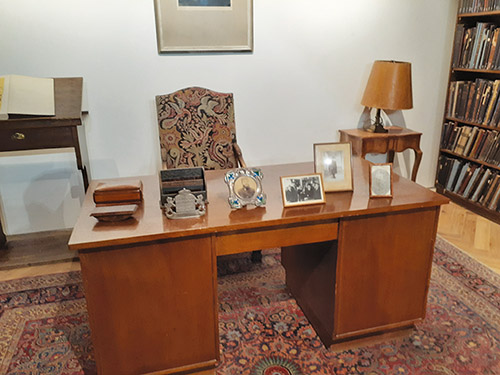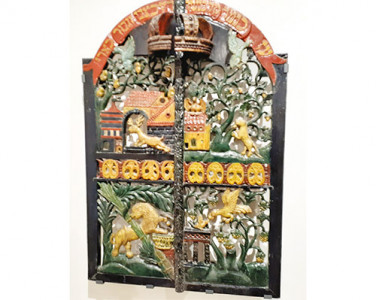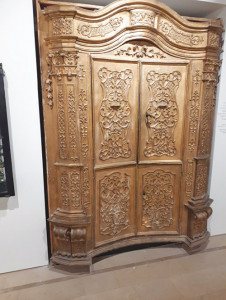
Those of us who are fortunate enough to have visited Jerusalem often are always looking for new sites to tour in the City of Gold. On our recent trip, we were delighted to discover The Wolfson Museum of Jewish Art housed at Heichal Shlomo, the former seat of the Chief Rabbinate of Israel.
No doubt in your travels in and about Yerushalayim you have passed Heichal Shlomo numerous times either on your way to the adjacent Great Synagogue or the nearby Plaza and Prima Hotels, and even on your way down to Ben Yehuda. May I suggest that you set aside one hour to visit the Wolfson Museum on the third floor of Heichal Shlomo for a unique and meaningful experience.
The historic Heichal Shlomo, designed by German architect Alexander Friedman, was erected between 1953 and 1958. It housed the seat of the Chief Rabbinate of Israel until recently. The Renanim Synagogue, located on the entrance level, was transferred from Padua, Italy, together with its 18th-century Torah Ark and bimah and original stained-glass windows. In the corridor on the main floor, the walls host a rotating exhibit of Israeli artists.

Since 1992, the building has housed The Wolfson Museum of Jewish Art on its third floor. The museum, recently renovated, is composed of 10 display rooms located around a circular corridor. The rooms display approximately 5,000 Jewish ceremonial objects, including archeological items, some of which date back to the Second Temple period—a collection that is considered among the world’s finest.
On your guided tour, you will hear the distinctive stories of so much of the permanent collection. One room is a recreation of the library of Israel’s first Chief Rabbi Yitzchak Halevi Herzog, grandfather of current President Isaac Herzog, in which he completed his renowned dissertation on the origins of the techeles used in tzitzit. Rotating exhibits display articles from present-day communities around the world. On our tour, we viewed the timely collection of chanukiyot from different historical periods and from throughout the world.
The highlight of our experience was one particular room which was attributed to Israeli visionary Moshe Moshkowitz, who passed away at the age of 96 in February 2020. A little background about this extraordinary individual will help appreciate this special exhibit. He was known to his admirers as “Moshko,” and many educational and settlement projects of the Religious-Zionist Movement over the past 80 years benefitted from his hard work and wisdom.
After the fall of his settlement of Masuot Yitchak to the Jordanians in 1945, Moshko helped establish two religious kibbutz towns in the Shafrir region to give renewed life to the widows and orphans of Gush Etzion. He helped establish the Alon Shvut Association including Yeshivat Har Etzion and the Alon Shvut Town around it. He served as the founding mayor of Efrat after taking part in its establishment. Among his other major accomplishments, he chaired the Herzog Academic College, which is now housed at Heichal Shlomo.

The walls of this unforgettable room are lined with bookcases housing closely packed, aged volumes of Jewish works. Some of the bindings look as if they are about to crumble. An explanatory wall panel points out that by placing each volume so close to its neighbor, the artist was expressing that the removal of even one small volume would result in the collapse of all of the volumes—a clear call for the unity and cohesiveness of the Jewish people.
Adding to this memorable display is one corner of the ceiling from which approximately 20 skinny, elongated beige canvas bags are hung. The soft and somber background music adds to the ambience when the visitor learns that each bag contains a holy sefer Torah saved from destruction by the Nazi regime, which attempted to get hold of every Torah scroll throughout Europe and display them in a Museum to a Decadent Culture. Through his menorah organization, Moshko traveled with a delegation of rabbis and Torah scholars to the National Library of Vilna where they managed to liberate 300 desecrated sifrei Torah destined for obliteration and bring them back to Israel for proper burial or revival. Of these 300, 20 are hung along the ceiling of this room as mementos of the Jewish life and civilization that the Nazis were not able to destroy.
To arrange for a tour of the Wolfson Museum of Jewish Art at Heichal Shlomo, located at 58 King George Street, call 02-568-9010.
By Pearl Markovitz










